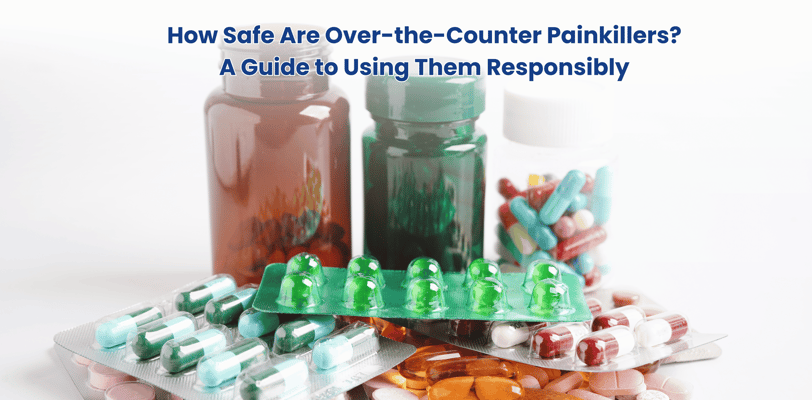How Safe Are Over-the-Counter Painkillers? – A Guide to Using Them Responsibly
When you have a headache, fever, or muscle pain, over-the-counter (OTC) painkillers are the easiest solution. These medicines, available without a prescription, help relieve pain quickly. But are they completely safe? Can you take them anytime you want? Let’s break down everything you need to know about using OTC painkillers safely!
2/17/20252 min read


🔹 What Are Over-the-Counter Painkillers?
OTC painkillers are medications available without a doctor’s prescription to relieve pain, fever, or inflammation. The most common types include:
✅ 1. Paracetamol (Acetaminophen)
Uses: Treats headaches, fever, and mild-to-moderate pain.
Brand Examples: Crocin, Calpol, Tylenol.
Caution: High doses can cause liver damage.
✅ 2. Non-Steroidal Anti-Inflammatory Drugs (NSAIDs)
Includes:
Ibuprofen (Brufen, Advil)
Naproxen (Naprosyn)
Uses: Effective for muscle pain, joint pain, menstrual cramps, and inflammation.
Caution: Long-term use can lead to stomach ulcers, kidney damage, and heart issues.
✅ 3. Aspirin (Acetylsalicylic Acid)
Uses: Relieves pain, fever, and is often used as a blood thinner for heart patients.
Caution: Not recommended for children due to the risk of Reye’s syndrome, a rare but serious condition.
🔹 Are OTC Painkillers Completely Safe?
While OTC painkillers are generally safe when used correctly, they can become dangerous if misused. Here are some key risks:
⚠️ 1. Liver Damage from Paracetamol
Taking too much paracetamol can lead to severe liver damage, especially when combined with alcohol.
✔ Safe Use: Never exceed 4,000 mg per day (usually 8 tablets of 500 mg).
⚠️ 2. Stomach Issues from NSAIDs
Long-term use of ibuprofen, aspirin, or naproxen can irritate the stomach lining, causing ulcers, heartburn, or internal bleeding.
✔ Safe Use: Take NSAIDs with food or milk to reduce stomach irritation.
⚠️ 3. Kidney and Heart Risks
NSAIDs can reduce blood flow to the kidneys, leading to kidney damage, and long-term use may increase the risk of heart attacks and strokes.
✔ Safe Use: Avoid frequent NSAID use if you have heart or kidney disease.
⚠️ 4. Risk of Allergic Reactions
Some people may experience skin rashes, breathing difficulties, or swelling after taking painkillers.
✔ Safe Use: If you experience an allergic reaction, stop taking the medicine and seek medical help immediately.
⚠️ 5. Harmful Drug Interactions
Painkillers can interact with other medications, leading to dangerous effects.
✔ Safe Use: Consult your doctor before taking OTC painkillers if you are on blood thinners, diabetes medications, or blood pressure drugs.
🔹 Safe Tips for Using OTC Painkillers
To minimize risks, follow these simple but essential safety tips:
✅ Follow Dosage Instructions – Never exceed the recommended dose on the label.
✅ Avoid Mixing Painkillers – Do not take multiple painkillers together unless advised by a doctor.
✅ Use for Short-Term Relief – If pain persists for more than a few days, consult a doctor instead of increasing the dose.
✅ Stay Hydrated – Drink plenty of water when taking painkillers to help your kidneys process them.
✅ Check Expiry Dates – Expired medicines may become ineffective or harmful.
✅ Avoid Alcohol – Alcohol increases the risk of liver damage with paracetamol and stomach issues with NSAIDs.
🔹 When Should You See a Doctor?
Seek medical advice if:
🚨 Pain persists for more than 3-5 days even after taking painkillers.
🚨 You experience side effects like nausea, dizziness, stomach pain, or breathing difficulties.
🚨 You have an existing medical condition (e.g., liver disease, kidney disease, heart problems) before taking painkillers.
🔹 Final Thoughts: Use Painkillers Wisely!
OTC painkillers are a quick and effective solution for pain relief, but they are not risk-free. Always use them responsibly, follow dosage guidelines, and consult a doctor for long-term or severe pain.
By staying informed and cautious, you can relieve pain safely without harming your health!
